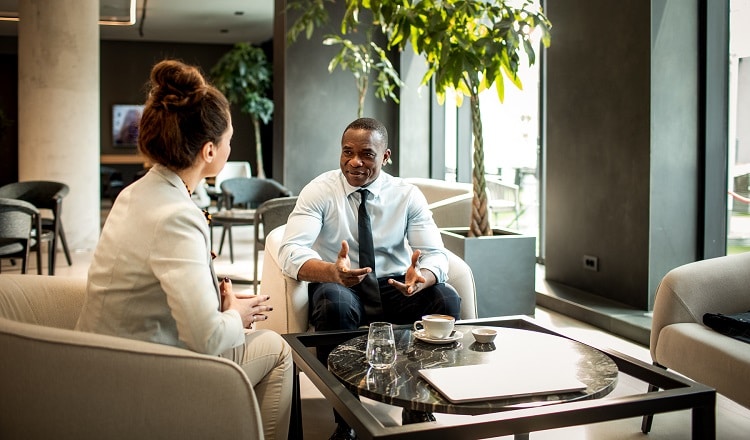This article first appeared on LinkedIn in April 2025.
Leadership today is more demanding than ever. Executives and people managers are expected to navigate complexity, inspire teams, and drive business outcomes—all while staying authentic and adaptable. Therefore, a strong leadership presence goes well beyond looking the part: it is about leading with purpose, clarity, and impact.
Throughout our careers, we have seen firsthand that the most effective leaders are those who are curious about the world around them, embrace continuous learning, cultivate their unique strengths, and make meaningful connections with their audiences.
In our experience, five key principles can enable leaders to show up for their teams and stakeholders in a way that resonates and drives meaningful impact.
Be a learner, thinker, and doer
Great leaders have an insatiable drive to learn, challenging themselves to think critically, execute decisively, and inspire others around them to do the same. In any executive role, you will face situations where you don’t have all the answers. What sets strong leaders apart is their ability to process information quickly, ask the right questions, and apply insights in real time.
We believe in the power of strategic thinking—breaking down complex problems, structuring solutions, and staying open to different perspectives. But thinking alone isn’t enough. The best leaders are also able to pair strategic insight with decisive action, knowing that forward momentum—even with the occasional failure—is key to growth.
Waynn and Shea Lih discuss the response to their LinkedIn article
Leading For Impact, with Waynn and Shea Lih
Music starts.
Waynn Wu, Chief Strategy Officer, PMI, speaks:
Are you ready?
Shea Lih Goh, President, Philip Morris Japan, replied:
Yes.
I was genuinely surprised, encouraged by the response to the article
and the conversation that it has sparked.
Waynn speaks:
When you said yes to it,
I was literally, like, jumping up and down
and thinking the fact that, yes, you know, finally,
I find the perfect person to be able to do it.
So to start, thank you, thank you and thank you.
Why did you decide to co-author an article with me?
Shea speaks:
If I were to be really honest, I was very hesitant
because co-authoring an article or even doing
an article is totally something new to me.
But I guess it was your infectious enthusiasm,
that really inspired me to say,
why not take this challenge, right?
Waynn speaks:
I've always wanted to do something meaningful with you.
Building business together is meaningful enough,
I have to say, but meaningful in a way that that touches people
to actually have the opportunity to work on,
principles of growth and principles of, professionalism.
And that is something I've always wanted
to do for a long, long time.
I finally find a perfect person to do it with so, thank you.
Shea said:
Leadership is still some slight inherent trait,
but I've come to realize over the years
is actually a evolution of journey,
which is shaped by experiences and self-reflection.
And it's also interesting because you shared with me
there were also some questions
from some of the readers about how do you get there?
Waynn said: Yeah.
Shea speaks:
So I would say that you know,
all the five principles are underlying theme,
but this is the thing that, I kind of wish somebody told me
maybe they did tell me, but without the experience
and, you know, the reflection,
you don't realize that it's actually a journey.
As the famous saying you unlearn, learn and re-learn.
I think I have learned that is so, so true,
but it is also extremely difficult
sometimes if you know you are not aware of this
or sometimes ego stops people, right.
So, I think this is a part that all of us will have to be very open to embrace.
Waynn speaks:
In order to be authentic, it is actually...
you beautifully describe around a journey.
It is not a moment in time to... it's not the
how to get there because as an individual
we all grow and as an individual we evolve over time.
People around us, personal, professional and even our
very own set of friends and family.
Everybody is growing older by the day,
nobody grows younger by the day anyway.
So, if you don't spend a disproportionate
amount of time understanding who you are,
it's almost impossible to know what who you want to become.
And then last but not least,
I will embrace and absolutely love myself.
And that, I think, is, my way of interpreting, authenticity.
Shea speaks: I knew that I like what you said, love yourself
because I think while we all want to be critical of sometimes of, you know,
what we do, who we are and all the mistakes,
but often, sometimes we can do to extremely become too harsh.
I think it's really important
that you also recognize the small steps and achieve when you make.
Waynn speaks:
Out of the five principles, do you have one in mind that, comes quite natural to you,
which almost like intuitive, I don't really have to work on it.
Shea speaks:
As a person, I'm inherently curious.
And I like to explore.
So, it lets me delve into new ideas,
see new perspective, compare what is out there, what is better.
So, it's very much me as a person.
So, I found it and probably the one that, you know, it comes naturally.
But it is also the driving force for me to stay,
you know, like updated in what is happening out there.
So I would say is, stay curious.
Waynn speaks:
I will have to pick, being different not just being the best.
Being different part is something that is very, very, natural to me.
There's a high price to pay to be the best.
But once you are the best, you very quickly also realize that you need to be,
intrinsically understanding what, sustainable competitive advantage
you have or you don't and be different.
And I would think that I had an
easier time now that I've grown in, my experience,
but when I first started out, when I was in my early 20s,
I have a harder time, because you tend to want to conform.
But now I'm just me, Shea Lih.
So, take it or leave it.
What would you say will be the one thing that,
'Wow, I have to work on it.'?
Shea speaks: Trying to embrace different perspective, different expectations,
cultural differences, you know, there's something
that again, it is not immediately natural.
And that takes a lot of hard work.
So number one, the active listening skills.
That's hard work.
Because listening is one thing, but active listening is another one.
It's about mastering the art of tailoring messages and adapting
communication styles to the different audience.
So, I think that part is a continuous work
and also because we know when is a team
member of 2 people, 5 people or 10 people
I found it so easy to motivate them
because we could say, let's all go
and celebrate everybody's birthday and let's all go
and have a karaoke, or let's go to have a dinner.
But then when it grows to 50, okay, that's totally different now.
And then when you go to 100, 500, 1000...
I learned the hard way that what I say said
that you know, the story and what ended the bottle.
Did I say that?
It definitely no.
But then how do you
then make sure this communication goes there?
It's like you have to manage ups,
you have to manage downwards and you have to manage across.
And then you have all the diversity of nationalities,
people with different backgrounds,
which makes it very challenging.
So on one hand is challenging, but it's also enjoyable.
Waynn speaks: And when I hear you speak about communicating,
I also have to be very honest, as you get a bit more senior,
you realize that, having key messages is one thing.
A really good storytelling is another.
We are not born to be able to do this like this.
The ability to storytell is absolutely, hugely trainable.
You have to spend a disproportionate
amount of time understanding who the audience are,
more importantly, what is it that they want to hear and why you?
You give the energy to the people,
the people will also give the energy to you.
And I think the communicating, style and the leadership style,
you just have to get comfortable with it,
and I think for me, it's a continuous journey and each time
I'm given the opportunity of a different platform,
I also find myself that I learn a lot more about myself.
Let's be also quite transparent.
The work that we're doing, we thought we were done
with the article, but very quickly
we realized that the engagement level is so high
that we kind of got curious around, like, how can we get the
how can we leverage the communication, engagement
and tools to bring this forward and have a more, you know, kind of bilateral communication
with people that found interest in the article.
Ourselves are curious and ourselves are learning
and last but not least, you know, here we are.
We're meeting the people exactly where they are.
What we can potentially be working on, I think also
depends on the feedback to this, because, it's not about us.
None of this is about us.
It's really about, the conversations,
or one-on-one conversations we had after the article
that brought us to do what we are doing now.
And I think, a rightful, tribute, to all this time and effort,
that everybody has spent on this is give us the feedback.
What would you, what would you like to know
if there's something we can work on, great.
We do that, but if it's not something
that we can work upon,
potentially we can pass it on
to some other friends and families
or even co-workers that could work upon
because I think that's what community building is about.
Shea speaks:
Hey. Oh, thank you so much.
Waynn speaks:
Thank you. Oh, it's a lot easier than I thought, No?
Music ends.
Meet people where they are
Leading with impact is not about being the loudest voice in the room—it is about creating rapport. One of the most overlooked leadership skills is the ability to tailor your messaging to different audiences. Effective leaders recognize that the same message can land differently depending on the context, culture, and mindset of the people they are addressing. The ability to bridge these gaps not only fosters trust but also ensures that ideas gain traction and inspire action.
We learned this firsthand while leading teams across multiple countries: leadership isn’t static—it requires adapting your communication style to ensure what you say and how you say it resonates across cultures and generations. Whether engaging with employees, business partners, or industry peers, the best leaders take the time to understand their audience, adjust their approach, and ensure their message lands with impact.
Stay curious
Leadership is an ongoing journey, not a fixed destination. The moment you stop learning, you risk falling behind. The best leaders remain students of their craft, constantly seeking new insights, asking questions and refining their perspectives. In an ever-evolving business landscape, the ability to be curious, learn, unlearn, and adapt is what separates those who thrive from those who plateau.
For example, we embrace curiosity in our everyday lives, both personal and professional—whether it’s observing consumer trends and innovations of different brands while shopping, immersing ourselves in unique environments while traveling, or taking time to ask questions and seek feedback from our colleagues. This approach broadens our perspective, helping us connect with different audiences, anticipate trends, and lead with greater adaptability.
Waynn Wu,
Chief Strategy Officer & Global Head PD; President, Philip Morris Equity Partner,
Philip Morris International
Shea Lih Goh,
President,
Philip Morris Japan
Stay composed and decisive
Leadership comes with pressure—there is no avoiding it. Navigating challenges requires both emotional intelligence and the ability to make tough calls with confidence. The most effective leaders also meet adversity, but they can remain steady in the face of it. By managing emotions, staying solution-focused, and projecting confidence, they create an environment where teams feel supported and empowered to tackle challenges head-on.
We have relied on a structured approach to decision-making in high-pressure situations. Start by breaking down problems into manageable components, allowing yourself to focus on solutions rather than becoming overwhelmed. In moments of uncertainty, strive to stay composed, knowing that maintaining a steady demeanor fosters trust and reassures your team. Whether in crisis situations or high-stakes negotiations, the ability to remain calm, gather input, and act decisively is a hallmark of great leadership.
Focus on being different, not just best
One of the most common leadership traps is chasing an outdated definition of success. Many executives strive to be “the best” in their field, but true impact often comes from the new or different perspectives leaders can impart to their organizations. This is about bringing a unique perspective, challenging conventions, and redefining what success looks like in their space.
Throughout our careers, we have had the privilege of learning from brilliant mentors, and some of those early conversations continue to shape our leadership philosophies today. Understanding that differentiation, rather than competition, is what drives lasting influence is a great example. Leaders who embrace their individuality—while staying deeply aligned with business priorities—tend to build lasting credibility and impact.
Today, we view our careers through the lens of three key variables—time, money, and health. We have learned that at different stages of leadership, the balance shifts, requiring constant recalibration. The most effective leaders recognize these evolving trade-offs, remain open to new perspectives, and adapt their approach to meet people where they are—because growth is not a fixed destination, but a continuous process of learning and refinement.
The leadership journey is complex, but the most impactful leaders are those who remain true to themselves while continuously evolving. The challenge isn’t just to lead—it is to lead in a way that inspires and empowers those around you, to drive individual and business success.





